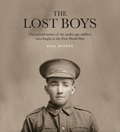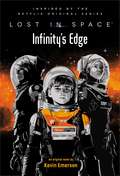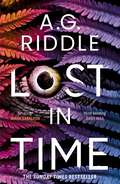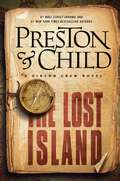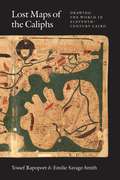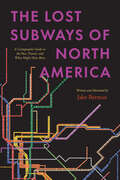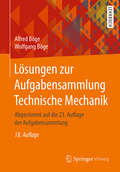- Table View
- List View
Loss Control Auditing: A Guide for Conducting Fire, Safety, and Security Audits (Occupational Safety & Health Guide Series)
by E. Scott DunlapLoss Control Auditing: A Guide for Conducting Fire, Safety, and Security Audits is a one-stop resource for both developing and executing a loss control audit program. This fully updated second edition addresses loss control auditing from the perspectives of workplace safety, physical security, and fire risks. It focuses on the three core areas of an audit: documentation review, physical inspection, and employee interviews, and presents a three-phase model – pre-audit, audit, and post-audit activities – which can be used for all three core areas. This new edition benefits from the addition of auditing and system measurement material as promulgated in ISO 45001 and ANSI/ASSP Z10 standards and the Occupational Safety and Health Administration’s Recommended Practices for Safety and Health Programs. It offers an expanded discussion of the application of auditing to the field of emergency management and new text explaining how leading and lagging measures can be used in the auditing process during assessment as well as in the post-audit evaluation. Subsidiary organizations and their integration into the auditing process, such as the areas of contractor management and temporary worker safety are covered in detail. The book discusses the integration of qualitative and quantitative measures in an effort to arrive at a more holistic scoring mechanism to assess organizational performance. In all, the depth of material presented in this thorough book showcases how to develop and execute a loss control management system audit program to a high quality. An ideal read for industry professionals, students, and postgraduates in the fields of fire service, loss prevention, and safety management.
Loss Control Auditing: A Guide for Conducting Fire, Safety, and Security Audits (Occupational Safety & Health Guide Series)
by E. Scott DunlapLoss Control Auditing: A Guide for Conducting Fire, Safety, and Security Audits is a one-stop resource for both developing and executing a loss control audit program. This fully updated second edition addresses loss control auditing from the perspectives of workplace safety, physical security, and fire risks. It focuses on the three core areas of an audit: documentation review, physical inspection, and employee interviews, and presents a three-phase model – pre-audit, audit, and post-audit activities – which can be used for all three core areas. This new edition benefits from the addition of auditing and system measurement material as promulgated in ISO 45001 and ANSI/ASSP Z10 standards and the Occupational Safety and Health Administration’s Recommended Practices for Safety and Health Programs. It offers an expanded discussion of the application of auditing to the field of emergency management and new text explaining how leading and lagging measures can be used in the auditing process during assessment as well as in the post-audit evaluation. Subsidiary organizations and their integration into the auditing process, such as the areas of contractor management and temporary worker safety are covered in detail. The book discusses the integration of qualitative and quantitative measures in an effort to arrive at a more holistic scoring mechanism to assess organizational performance. In all, the depth of material presented in this thorough book showcases how to develop and execute a loss control management system audit program to a high quality. An ideal read for industry professionals, students, and postgraduates in the fields of fire service, loss prevention, and safety management.
The Lost Boys
by Paul ByrnesIn the First World War of 1914–1918, thousands of boys across Australia and New Zealand lied about their age, forged a parent’s signature and left to fight on the other side of the world. Though some were as young as thirteen, they soon found they could die as well as any man. Like Peter Pan’s lost boys, they have remained forever young. These are their stories. This extraordinary book captures the incredible and previously untold stories of forty Anzac boys who fought in the First World War, from Gallipoli to the Armistice. Featuring haunting images of the boys taken at training camps and behind the lines, these tales are both heartbreaking and rousing, full of daring, ingenuity, recklessness, random horror and capricious luck. A unique perspective on the First World War, The Lost Boys is military history made deeply personal, a powerful homage to youthful bravery and a poignant reminder of the sacrifice of war.
Lost in a Good Game: Why we play video games and what they can do for us
by Pete Etchells'Etchells writes eloquently ... A heartfelt defence of a demonised pastime' The Times 'Once in an age, a piece of culture comes along that feels like it was specifically created for you, the beats and words and ideas are there because it is your life the creator is describing. Lost In A Good Game is exactly that. It will touch your heart and mind. And even if Bowser, Chun-li or Q-Bert weren't crucial parts of your youth, this is a flawless victory for everyone' Adam Rutherford When Pete Etchells was 14, his father died from motor neurone disease. In order to cope, he immersed himself in a virtual world - first as an escape, but later to try to understand what had happened. Etchells is now a researcher into the psychological effects of video games, and was co-author on a recent paper explaining why WHO plans to classify ‘game addiction’ as a danger to public health are based on bad science and (he thinks) are a bad idea. In this, his first book, he journeys through the history and development of video games - from Turing’s chess machine to mass multiplayer online games like World of Warcraft- via scientific study, to investigate the highs and lows of playing and get to the bottom of our relationship with games - why we do it, and what they really mean to us. At the same time, Lost in a Good Game is a very unusual memoir of a writer coming to terms with his grief via virtual worlds, as he tries to work out what area of popular culture we should classify games (a relatively new technology) under.
Lost in Space: Infinity's Edge (Lost in Space #2)
by Kevin EmersonThe second thrilling, original novel based on Netflix's smash hit Lost in Space! This all-new story focuses on twelve-year-old Will Robinson and his closest friend and greatest protector--a mysterious Robot with a dangerous past.The Robinsons--Will, his two teenage sisters, and their parents--are members of a colonist group who had been traveling across the galaxy to establish a new home, only to have had their ship attached and stranded on an alien planet. Just when they had finally managed to get off-world, the Robinsons were thrown off course yet again and were sent drifting toward an unknown location.Now, six months later, the Robinsons are stuck on an inhospitable water planet with no contact from their fellow colonists or from Will's beloved Robot. The twelve-year-old doesn't have any friends in his new home, until he discovers a mysterious girl...from the future. Her name is Clare, and she desperately needs Will's help to save her family. Will is eager to bond with his new friend, but--little does he know--something sinister lurks just beneath her surface. Can Will find a way to help Clare while keeping his own family safe?© 2020 Legendary. All Rights Reserved.
Lost in Time
by A.G. RiddleThe SUNDAY TIMES bestseller"Amazing! One of the twistiest time-tales I've ever read." –Diana Gabaldon"Crichtonesque thrillers don't come much better than this... Readers won't be able to turn the pages fast enough." –Publishers Weekly (Starred Review)"Are we talking plot twists? More like spirals. Gripping, clever, mind-bending stuff." –Daily MailFrom the worldwide bestselling author of Departure and Winter World comes a standalone novel about a father and daughter trying to unravel an intricate murder mystery spread across time – with a jaw-dropping twist.Control the past.Save the future.One morning, Dr. Sam Anderson wakes up to find that the woman he loves has been murdered.For Sam, the horror is only beginning.He and his daughter are accused of the crime. The evidence is ironclad. They will be convicted.And so, to ensure his daughter goes free, Sam does what he must: he confesses.But in the future, murderers aren't sent to prison.Thanks to a machine Sam helped invent, the world's worst criminals are now sent to the past – approximately 200 million years into the past, to the dawn of the time of the dinosaurs – where they must live out their lives alone, in exile from the human race.Sam accepts his fate.But his daughter doesn't.Adeline Anderson has already lost her mother to a deadly, unfair disease. She can't bear to lose her father as well.So she sets out on a quest to prove him innocent. And to get him back. People around her insist that both are impossible tasks.But Adeline doesn't give up. She only works harder.She soon learns that impossible tasks are her specialty. And that she is made of tougher stuff than she ever imagined.As she peels back the layers of the mystery that tore her father from this world, Adeline finds more questions than answers. Everyone around her is hiding a secret. But which ones are connected to the murder that exiled her father?That mystery stretches across the past, present, and future – and leads to a revelation that will change everything.
The Lost Island (Gideon Crew #3)
by Douglas Preston Lincoln ChildGideon Crew – brilliant scientist, master thief – is living on borrowed time. When he's handed an eyebrow-raising mission by his mysterious employer, Gideon has no reason to refuse. His task? To steal a page from the priceless Book of Kells, now on display in New York City, protected by unbreakable security. Accomplishing the impossible, Gideon steals the parchment – only to learn that hidden beneath the gorgeously illuminated image is a treasure map dating back to the time of the ancient Greeks, treasure that could, perhaps, save Gideon's life.
Lost Maps of the Caliphs: Drawing the World in Eleventh-Century Cairo
by Yossef Rapoport Emilie Savage-SmithAbout a millennium ago, in Cairo, an unknown author completed a large and richly illustrated book. In the course of thirty-five chapters, this book guided the reader on a journey from the outermost cosmos and planets to Earth and its lands, islands, features, and inhabitants. This treatise, known as The Book of Curiosities, was unknown to modern scholars until a remarkable manuscript copy surfaced in 2000. Lost Maps of the Caliphs provides the first general overview of The Book of Curiosities and the unique insight it offers into medieval Islamic thought. Opening with an account of the remarkable discovery of the manuscript and its purchase by the Bodleian Library, the authors use The Book of Curiosities to re-evaluate the development of astrology, geography, and cartography in the first four centuries of Islam. Their account assesses the transmission of Late Antique geography to the Islamic world, unearths the logic behind abstract maritime diagrams, and considers the palaces and walls that dominate medieval Islamic plans of towns and ports. Early astronomical maps and drawings demonstrate the medieval understanding of the structure of the cosmos and illustrate the pervasive assumption that almost any visible celestial event had an effect upon life on Earth. Lost Maps of the Caliphs also reconsiders the history of global communication networks at the turn of the previous millennium. It shows the Fatimid Empire, and its capital Cairo, as a global maritime power, with tentacles spanning from the eastern Mediterranean to the Indus Valley and the East African coast. As Lost Maps of the Caliphs makes clear, not only is The Book of Curiosities one of the greatest achievements of medieval mapmaking, it is also a remarkable contribution to the story of Islamic civilization that opens an unexpected window to the medieval Islamic view of the world.
Lost Maps of the Caliphs: Drawing the World in Eleventh-Century Cairo
by Yossef Rapoport Emilie Savage-SmithAbout a millennium ago, in Cairo, an unknown author completed a large and richly illustrated book. In the course of thirty-five chapters, this book guided the reader on a journey from the outermost cosmos and planets to Earth and its lands, islands, features, and inhabitants. This treatise, known as The Book of Curiosities, was unknown to modern scholars until a remarkable manuscript copy surfaced in 2000. Lost Maps of the Caliphs provides the first general overview of The Book of Curiosities and the unique insight it offers into medieval Islamic thought. Opening with an account of the remarkable discovery of the manuscript and its purchase by the Bodleian Library, the authors use The Book of Curiosities to re-evaluate the development of astrology, geography, and cartography in the first four centuries of Islam. Their account assesses the transmission of Late Antique geography to the Islamic world, unearths the logic behind abstract maritime diagrams, and considers the palaces and walls that dominate medieval Islamic plans of towns and ports. Early astronomical maps and drawings demonstrate the medieval understanding of the structure of the cosmos and illustrate the pervasive assumption that almost any visible celestial event had an effect upon life on Earth. Lost Maps of the Caliphs also reconsiders the history of global communication networks at the turn of the previous millennium. It shows the Fatimid Empire, and its capital Cairo, as a global maritime power, with tentacles spanning from the eastern Mediterranean to the Indus Valley and the East African coast. As Lost Maps of the Caliphs makes clear, not only is The Book of Curiosities one of the greatest achievements of medieval mapmaking, it is also a remarkable contribution to the story of Islamic civilization that opens an unexpected window to the medieval Islamic view of the world.
Lost Maps of the Caliphs: Drawing the World in Eleventh-Century Cairo
by Yossef Rapoport Emilie Savage-SmithAbout a millennium ago, in Cairo, an unknown author completed a large and richly illustrated book. In the course of thirty-five chapters, this book guided the reader on a journey from the outermost cosmos and planets to Earth and its lands, islands, features, and inhabitants. This treatise, known as The Book of Curiosities, was unknown to modern scholars until a remarkable manuscript copy surfaced in 2000. Lost Maps of the Caliphs provides the first general overview of The Book of Curiosities and the unique insight it offers into medieval Islamic thought. Opening with an account of the remarkable discovery of the manuscript and its purchase by the Bodleian Library, the authors use The Book of Curiosities to re-evaluate the development of astrology, geography, and cartography in the first four centuries of Islam. Their account assesses the transmission of Late Antique geography to the Islamic world, unearths the logic behind abstract maritime diagrams, and considers the palaces and walls that dominate medieval Islamic plans of towns and ports. Early astronomical maps and drawings demonstrate the medieval understanding of the structure of the cosmos and illustrate the pervasive assumption that almost any visible celestial event had an effect upon life on Earth. Lost Maps of the Caliphs also reconsiders the history of global communication networks at the turn of the previous millennium. It shows the Fatimid Empire, and its capital Cairo, as a global maritime power, with tentacles spanning from the eastern Mediterranean to the Indus Valley and the East African coast. As Lost Maps of the Caliphs makes clear, not only is The Book of Curiosities one of the greatest achievements of medieval mapmaking, it is also a remarkable contribution to the story of Islamic civilization that opens an unexpected window to the medieval Islamic view of the world.
Lost Maps of the Caliphs: Drawing the World in Eleventh-Century Cairo
by Yossef Rapoport Emilie Savage-SmithAbout a millennium ago, in Cairo, an unknown author completed a large and richly illustrated book. In the course of thirty-five chapters, this book guided the reader on a journey from the outermost cosmos and planets to Earth and its lands, islands, features, and inhabitants. This treatise, known as The Book of Curiosities, was unknown to modern scholars until a remarkable manuscript copy surfaced in 2000. Lost Maps of the Caliphs provides the first general overview of The Book of Curiosities and the unique insight it offers into medieval Islamic thought. Opening with an account of the remarkable discovery of the manuscript and its purchase by the Bodleian Library, the authors use The Book of Curiosities to re-evaluate the development of astrology, geography, and cartography in the first four centuries of Islam. Their account assesses the transmission of Late Antique geography to the Islamic world, unearths the logic behind abstract maritime diagrams, and considers the palaces and walls that dominate medieval Islamic plans of towns and ports. Early astronomical maps and drawings demonstrate the medieval understanding of the structure of the cosmos and illustrate the pervasive assumption that almost any visible celestial event had an effect upon life on Earth. Lost Maps of the Caliphs also reconsiders the history of global communication networks at the turn of the previous millennium. It shows the Fatimid Empire, and its capital Cairo, as a global maritime power, with tentacles spanning from the eastern Mediterranean to the Indus Valley and the East African coast. As Lost Maps of the Caliphs makes clear, not only is The Book of Curiosities one of the greatest achievements of medieval mapmaking, it is also a remarkable contribution to the story of Islamic civilization that opens an unexpected window to the medieval Islamic view of the world.
The Lost Subways of North America: A Cartographic Guide to the Past, Present, and What Might Have Been
by Jake BermanA visual exploration of the transit histories of twenty-three US and Canadian cities. Every driver in North America shares one miserable, soul-sucking universal experience—being stuck in traffic. But things weren’t always like this. Why is it that the mass transit systems of most cities in the United States and Canada are now utterly inadequate? The Lost Subways of North America offers a new way to consider this eternal question, with a strikingly visual—and fun—journey through past, present, and unbuilt urban transit. Using meticulous archival research, cartographer and artist Jake Berman has successfully plotted maps of old train networks covering twenty-three North American metropolises, ranging from New York City’s Civil War–era plan for a steam-powered subway under Fifth Avenue to the ultramodern automated Vancouver SkyTrain and the thousand-mile electric railway system of pre–World War II Los Angeles. He takes us through colorful maps of old, often forgotten streetcar lines, lost ideas for never-built transit, and modern rail systems—drawing us into the captivating transit histories of US and Canadian cities. Berman combines vintage styling with modern printing technology to create a sweeping visual history of North American public transit and urban development. With more than one hundred original maps, accompanied by essays on each city’s urban development, this book presents a fascinating look at North American rapid transit systems.
Lösungen zur Aufgabensammlung Technische Mechanik: Abgestimmt auf die 24. Auflage der Aufgabensammlung
by Alfred Böge Wolfgang BögeDieses Buch ist Teil des Lehr- und Lernsystems Technische Mechanik mit dem Lehrbuch als Basiswerk, der Aufgabensammlung und der Formelsammlung.Das Buch enthält die ausführlichen Lösungswege der über 900 Aufgaben und hilft zuverlässig beim Lösen einer Aufgabe und beim Nachschlagen, wenn Lösungsansätze nicht gefunden werden. In der aktuellen 19. Auflage wurden kleinschrittige analytische und trigonometrische Lösungswege ergänzt. Für vereinfachende Werte von Winkelfunktionen wurden die Zahlenwerte eingesetzt, um damit die Gleichungen wesentlich überschaubarer und Lösungswege einfacher zu machen.
Lösungen zur Aufgabensammlung Technische Mechanik: Abgestimmt auf die 23. Auflage der Aufgabensammlung
by Alfred Böge Wolfgang BögeDieses Buch ist Teil des Lehr- und Lernsystems Technische Mechanik mit dem Lehrbuch als Basiswerk, der Aufgabensammlung und der Formelsammlung.Das Buch enthält die ausführlichen Lösungsgänge der über 900 Aufgaben aus der Aufgabensammlung. Es hilft beim Lösen einer Aufgabe und beim Nachschlagen, wenn Lösungsansätze nicht gefunden werden. In der aktuellen Auflage wurden in zahlreichen Lösungen zusätzliche Lösungsschritte ergänzt und einige vollkommen neu konzipierte Lösungen zum besseren Verständnis aufgenommen.
Lösungen zur Aufgabensammlung Technische Mechanik: Abgestimmt auf die 25. Auflage der Aufgabensammlung
by Alfred Böge Wolfgang BögeDieses Buch ist Teil des Lehr- und Lernsystems Technische Mechanik mit dem Lehrbuch als Basiswerk, der Aufgabensammlung und der Formelsammlung. Die 20. Auflage ist abgestimmt auf die 25. Auflage der Aufgabensammlung Technische Mechanik. Ausführliche und detaillierte Lösungswege der über 900 Aufgaben kennzeichnen die aktuelle Auflage und helfen zielsicher beim Selbststudium. Es dient der Bestätigung der eigenen Arbeit beim Lösen einer Aufgabe und dem Nachschlagen, wenn Lösungsansätze nicht gefunden werden. Außerdem lassen sich anhand der Lösungsvorlagen z. B. Excel-Arbeitsblätter entwickeln, um Berechnungen mit variablen Ausgangswerten durchzuführen und zu visualisieren.
Lösungen zur Aufgabensammlung Technische Mechanik: Abgestimmt auf die 26. Auflage der Aufgabensammlung
by Alfred Böge Wolfgang BögeDieses Buch liefert als Teil des Lehr- und Lernsystems Technische Mechanik die ausführlichen Lösungen zur 26. Auflage der Aufgabensammlung und vervollständigt das 4-teilige System um das Lehrbuch als Basiswerk und die Formelsammlung. Detaillierte Lösungswege der über 900 Aufgaben umfassen analytische und trigonometrische Vorgehensweisen und helfen zielsicher beim Selbststudium. In der aktuellen Auflage wurden zudem einige zeichnerische Lösungen ergänzt, um das Verständnis der Mechanik und die eigenen Lernerfolge zusätzlich zu erweitern. Außerdem lassen sich anhand der Lösungsvorlagen z. B. Excel-Arbeitsblätter entwickeln, um Berechnungen mit variablen Ausgangswerten durchzuführen und zu visualisieren.
Lösungen zur Aufgabensammlung Technische Mechanik: Abgestimmt auf die 22. Auflage der Aufgabensammlung
by Alfred Böge Wolfgang Böge Walter SchlemmerDieses Buch ist Teil des Lehr- und Lernsystems Technische Mechanik mit dem Lehrbuch als Basiswerk, der Aufgabensammlung und der Formelsammlung.Das Buch enthält die ausführlichen Lösungsgänge der über 900 Aufgaben aus der Aufgabensammlung. Es hilft beim Lösen einer Aufgabe und beim Nachschlagen, wenn Lösungsansätze nicht gefunden werden. Neu sind die Lösungen der zwei Aufgaben zu Berechnungen der Schrägseilbrücke sowie eine Übersicht mit Erläuterungen der wichtigsten in den Lösungen verwendeten Symbole. In den Zeichnungen der Lösungen zur „Statik der Fachwerke“ sind nun alle Gelenke in den Knoten eingezeichnet worden.
Lösungen zur Aufgabensammlung Technische Mechanik (Viewegs Fachbücher der Technik)
by Alfred Böge Walter SchlemmerDas Buch enthält die ausführlichen Lösungsgänge der über 900 Aufgaben aus der Aufgabensammlung. Es dient der Bestätigung der eigenen Arbeit beim Lösen einer Aufgabe und dem Nachschlagen, wenn Lösungsansätze nicht gefunden werden. Außerdem lassen sich anhand der Lösungsvorlage für bestimmte Aufgabengruppen PC-Berechnungsprogramme leichter schreiben, zum Beispiel für die Ermittlung von Stützkräften an Wellen. Diese Auflage ist abgestimmt auf die 18. Auflage der Aufgabensammlung Technische Mechanik
Lösungen zur Aufgabensammlung Technische Mechanik: Abgestimmt auf die 20. Auflage der Aufgabensammlung
by Alfred Böge Walter SchlemmerDas Buch enthält die ausführlichen Lösungsgänge der über 900 Aufgaben aus der Aufgabensammlung. Es dient der Bestätigung der eigenen Arbeit beim Lösen einer Aufgabe und dem Nachschlagen, wenn Lösungsansätze nicht gefunden werden. Außerdem lassen sich anhand der Lösungsvorlage für bestimmte Aufgabengruppen PC-Berechnungsprogramme leichter schreiben, zum Beispiel für die Ermittlung von Stützkräften an Wellen. Diese Auflage ist abgestimmt auf die 20. Auflage der Aufgabensammlung Technische Mechanik.
Lösungen zur Aufgabensammlung Technische Mechanik: Abgestimmt auf die 21. Auflage der Aufgabensammlung
by Alfred Böge Walter SchlemmerDieses Buch ist Teil des Lehr- und Lernsystems Technische Mechanik mit dem Lehrbuch als Basiswerk, der Aufgabensammlung und der Formelsammlung.Das Buch enthält die ausführlichen Lösungsgänge der über 900 Aufgaben aus der Aufgabensammlung. Es dient der Bestätigung der eigenen Arbeit beim Lösen einer Aufgabe und dem Nachschlagen, wenn Lösungsansätze nicht gefunden werden. Das korrekte Freimachen von Bauteilen unter Annahme von verschiedenen Kraftrichtungen wird jetzt sehr ausführlich gezeigt. Konstruktive Hinweise aus der Lehrer- und Schülerschaft wurden eingearbeitet.
Lösungen zur Aufgabensammlung Technische Mechanik: Abgestimmt auf die 19. Auflage der Aufgabensammlung Technische Mechanik
by Alfred Böge Walter SchlemmerDas Buch enthält die ausführlichen Lösungsgänge der über 900 Aufgaben aus der Aufgabensammlung. Es dient der Bestätigung der eigenen Arbeit beim Lösen einer Aufgabe und dem Nachschlagen, wenn Lösungsansätze nicht gefunden werden. Außerdem lassen sich anhand der Lösungsvorlage für bestimmte Aufgabengruppen PC-Berechnungsprogramme leichter schreiben, zum Beispiel für die Ermittlung von Stützkräften an Wellen. Diese Auflage ist abgestimmt auf die 19. Auflage der Aufgabensammlung Technische Mechanik.
Lösungsbuch Speicherprogrammierte Steuerungen SPS: Lösungen der Übungsaufgaben (Viewegs Fachbücher der Technik)
by Günter Wellenreuther Dieter ZastrowLösungsbuch zur Analysis für technische Oberschulen: Ansätze, Lösungsschritte und Ergebnisse
by Karl-Heinz PfefferDieses Lösungsbuch gibt Sicherheit für das Selbststudium und berücksichtig die unterschiedlichen mathematischen Vorkenntnisse der Schüler. Es enthält die Ergebnisse der Aufgaben des Lehrbuches und ist somit für das Üben unentbehrlicher Bestandteil der Selbstkontrolle. Die aktuelle Auflage enthält jetzt alle Lösungen zu den Aufgaben.
Lösungsbuch zur Einführung in die Festigkeitslehre: Aufgaben, Ausführliche Lösungswege, Formelsammlung
by Volker LäppleDie sichere Auslegung von Bauteilen und Anlagen gehört zu den Grundfertigkeiten eines Ingenieurs. Fehlerhaft dimensionierte Bauteile können zu schweren Schäden und hohen Kosten führen, zum Beispiel beim Bersten eines Druckbehälters oder dem Einsturz einer Stahlkonstruktion. Dieses Lösungsbuch enthält zu allen Aufgaben des Lehr- und Übungsbuchs ausführliche Lösungen und wo sinnvoll, auch alternative Lösungsvorschläge. So kann der Studierende sein erlerntes Wissen überprüfen, anhand praxisorientierter Aufgaben anwenden und vertiefen. Er lernt Problemstellungen zu analysieren, wesentliche Zusammenhänge zu erfassen, ein mathematisch-physikalisches Modell zu formulieren und eine geeignete Lösungsstrategie zu entwickeln. Auch für eine eigenständige Klausurvorbereitung eignen sich beide Bücher. Der Ingenieur in der Praxis findet ebenfalls wertvolle Hinweise für die Entwicklung von Lösungsstrategien zur Durchführung von Festigkeitsnachweisen.
Lösungsbuch zur Einführung in die Festigkeitslehre: Aufgaben, Ausführliche Lösungswege, Formelsammlung
by Volker LäppleDie sichere Auslegung von Bauteilen und Anlagen gehört zu den Grundfertigkeiten eines Ingenieurs. Fehlerhaft dimensionierte Bauteile können zu schweren Schäden und hohen Kosten führen, zum Beispiel beim Bersten eines Druckbehälters oder dem Einsturz einer Stahlkonstruktion. Dieses Lösungsbuch enthält zu allen Aufgaben des Lehr- und Übungsbuchs ausführliche Lösungen und wo sinnvoll, auch alternative Lösungsvorschläge. So kann der Studierende sein erlerntes Wissen überprüfen, anhand praxisorientierter Aufgaben anwenden und vertiefen. Er lernt Problemstellungen zu analysieren, wesentliche Zusammenhänge zu erfassen, ein mathematisch-physikalisches Modell zu formulieren und eine geeignete Lösungsstrategie zu entwickeln. Auch für eine eigenständige Klausurvorbereitung eignen sich beide Bücher. Der Ingenieur in der Praxis findet ebenfalls wertvolle Hinweise für die Entwicklung von Lösungsstrategien zur Durchführung von Festigkeitsnachweisen.

